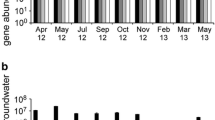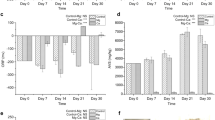Abstract
Samples were collected from organically polluted and unpolluted groundwater of sandy and gravelly deposits. After filtration onto polycarbonate filters (0.2μm pore size) the number of respiring bacteria was recorded by microscopically counting cells containing red INT-formazan spots, which characterize respiring bacteria. The total number of bacteria was simultaneously recorded by epifluorescence microscopy after staining with acridine orange. The number of respiring bacteria in the groundwater samples (55–490×103/cm3) is within the range of values for other aquatic biotopes, but as the total number of bacteria in groundwater was usually higher, the proportion of respiring groundwater bacteria (0.66–7. 4%) was lower. Mainly larger bacteria, rods, and bacteria on particles could be identified as being active, whereas hardly any respiratory activity could be detected among small cocci and free interstitial bacteria. If the supply of dissolved organic matter (DOM) is adequate, the biomass of respiring bacteria correlates well with oxygen concentration, but there is no direct correlation between DOM concentration in groundwater and active bacterial biomass. Nor could any relationship be observed between the biomass of total and respiring bacteria, or between the quantity of respiring bacteria and heterotrophic bacterial activity.
Similar content being viewed by others
References
Hirsch P, Rades-Rohkohl E (1983a) Die Zusammensetzung der natürlichen Grundwasser-Mikroflora und Untersuchungen über ihre Wechselbeziehungen mit Fäkalbakterien. DVGW-Schriftenreihe Wasser 35:59–80
Hirsch P, Rades-Rohkohl E (1983b) Microbial diversity in a groundwater aquifer in northern Germany. Developments in Industrial Microbiol 24:183–200
Hirsch P, Rades-Rohkohl E (1984) Untersuchung der Lebensdauer von Bakterien und Viren im Grundwasser im Hinblick auf die Ausweisung von Schutzgebieten für die Grundwassergewinnungsanlagen. Teilvorhaben: Durchführung von Feldexperimenten im Segeberger Forst (Untersuchung von Zusammensetzung und Aktivität der natürlichen Grundwassermikroflora); Durchführung von Labor-Modellexperimenten mit ausgewählten Mikroorganismenbzw. Phagenkulturen. Umweltforschungsplan des Bundesministers des Innern, Forschungsbericht (Wasser “102 02 202/04”):1–84
Iturriaga R, Rheinheimer G (1975) Eine einfache Methode zur Auszählung von Bakterien mit aktivem Elektronentransportsystem in Wasser- und Sedimentproben. Kiel Meeresforsch 31: 83–86
Kogure K, Simidu U, Taga N (1979) A tentative direct microscopic method for counting living marine bacteria. Can J Microbiol 25:415–420
Marxsen J (1981a) Fluoreszenzmikroskopische Untersuchung der Bakterienflora und Bestimmung ihrer heterotrophen Aktivität in organisch belastetem und unbelastetem Grundwasser sandig-kiesiger Ablagerungen. Int J Speleol 11:173–201
Marxsen J (1981b) Bacterial biomass and bacterial uptake of glucose in polluted and unpolluted groundwater of sandy and gravelly deposits. Verh Internat Verein Limnol 21:1371–1375
Marxsen J (1982) Ein neues Verfahren zur Untersuchung der bakteriellen Besiedlung grundwasserführender sandiger Sedimente. Arch Hydrobiol 95:221–233
Quinn JP (1984) The modification and evaluation of some cytochemical techniques for the enumeration of metabolically active heterotrophic bacteria in the aquatic environment. J Appl Bacteriol 57:51–57
Spinedi C, Wuhrmann K (1978) Über die mikrobielle Besiedlung von Grundwasserleitern. EAWAG Jahresbericht 1978:40
Staley JT (1968) Prosthecomicrobium and Ancalomicrobium: new prosthecate freshwater bacteria. J Bacteriol 95:1921–1942
Zimmerman R, Iturriaga R, Becker-Birck J (1978) Simultaneous determination of total number of aquatic bacteria and the number thereof involved in respiration. Appl Environ Microbiol 36:926–935
Author information
Authors and Affiliations
Rights and permissions
About this article
Cite this article
Marxsen, J. Investigations into the number of respiring bacteria in groundwater from sandy and gravelly deposits. Microb Ecol 16, 65–72 (1988). https://doi.org/10.1007/BF02097405
Issue Date:
DOI: https://doi.org/10.1007/BF02097405




